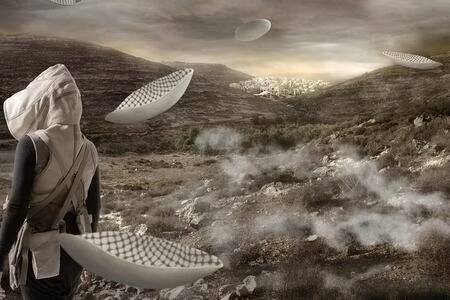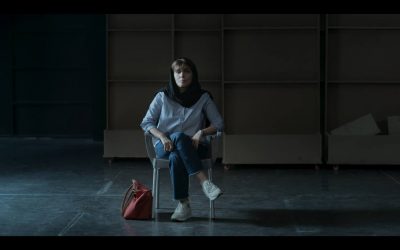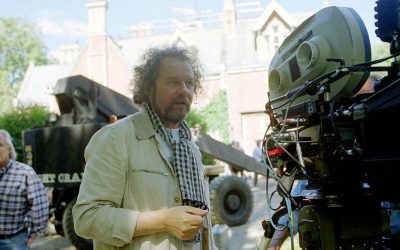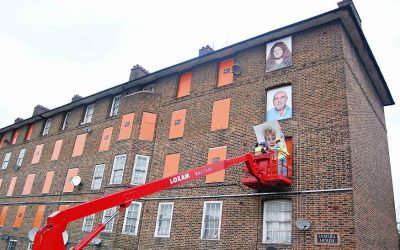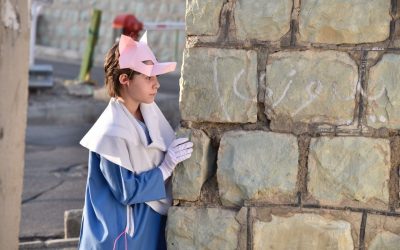Author: Katayoon Barzegar
Science fiction films are not about science; they are about disasters.
Susan Sontag – The Imagination of Disaster
The science fiction genre might be the last thing that comes to mind for a film about Palestine. The first question that arises is: when dealing with war, militarization, plunder, genocide, hunger, and displacement, why science fiction? For years, Larissa Sansour made documentaries about Palestine. According to her, the more she progressed, the less believable her narratives became to the audience. Some thought her allegiance to one side of the Palestine-Israel conflict led to biases and exaggerations in her stories. Therefore, Sansour decided to change her mode of expression and frame her narratives within the science fiction genre. In her view, the Palestine-Israel issue has long crossed the boundaries of reality, appearing more surreal. But what reasons and potentials lie behind this choice?
Jean-Luc Godard, the French director who made a documentary about the Palestinian struggle, once stated, “The Palestinians have become subjects for documentaries.” In Palestinian filmmaking, due to historical and geographical imperatives, there is a strong emphasis on narrating events that have been systematically and persistently erased or distorted. Consequently, many Palestinian filmmakers are involved in making documentaries, and even in their narrative and experimental films, they focus on portraying these factual accounts.
However, Larissa Sansour, a Palestinian artist, abandons the documentary form for various reasons and expresses her narrative through the science fiction genre. For Sansour, at a certain point, depicting Palestine in a surrealistic manner seemed more honest and allowed for the addition of more layers to her work. On the other hand, she aimed to disrupt the fixed framework of documentary filmmaking: “In the documentary format, the people depicted become subjects for analysis and observation, and the filmmaker becomes an analyst or an outsider dissecting them. Therefore, I made my films more seductive rather than documentary. By doing so, the audience, instead of merely sympathizing with or pitying the Palestinian people, becomes genuinely interested in them. And I think this disrupts an established balance and positioning that is important.
Using the science fiction genre, Hollywood aesthetics, and sometimes popular culture, Sansour employs a unique form to engage with her content. By leveraging the element of imagination without limits, she confronts these horrific and inevitable conditions, allowing us to envision alternatives or consider how things could be different if circumstances were otherwise. The power of imagining a different future is often harder to grasp in a patriarchal, militaristic, and capitalist world than envisioning the end of the world itself. In a dystopian setting where imagining tomorrow has become difficult, it is the realm of imagination that provides the essential space to conceive a different future. Sansour excavates the past, searching through this excavation for potential futures that currently seem seized and unattainable. By choosing this genre, it is as if she wants to say that documenting the present is no longer sufficient; the scale of the disaster is such that even documentaries cannot encompass the multiple layers of this history.
In her films, Sansour intertwines personal and collective memories and traumas with themes such as identity and belonging. By merging these elements with the aesthetics of science fiction cinema, she creates a unique fusion. Like many other artists, Sansour’s work represents a nation and land subjected to systematic erasure. Her films often start with the history of her own family and then extend to her nation. She frames this history within stories that typically emerge through dialogues between two women from different generations.Sansour’s storytellers are aware that recounting these tales puts their lives at risk, yet they embrace this danger to combat oblivion. Storytelling, for them, is a feminine act of resistance against forgetting—a forgetting that can be gradual or sudden, like a collective shock. At times, the narrators in Sansour’s films express their despair over an inescapable path and fate. They have no choice but to fight, despite the pain and exhaustion it brings them.The manifesto of Sansour’s works is evident in her narratives. She evaluates the importance of “story and myth” within a political context, exploring how historical narratives can become tools, akin to the science of archaeology. Her project “In the Future They Ate from the Finest Porcelain” delves into archaeology as a political tool, especially concerning the Palestine-Israel issue. Who gets to narrate? Which narrative becomes dominant? How does intervention in historical narrative occur?

Author: Katayoon Barzegar
In the film “In the Future They Ate from the Finest Porcelain,” the main character engages in a conversation with another woman, who, like a therapist, asks her questions to uncover the heroine’s story. This woman is executing a plan: she aims to change the narrative of history by burying special porcelain dishes (previously seen in Sansour’s work “Nation Estate”). These dishes contain the DNA of Palestinians, ensuring that future archaeologists will find them in their excavations. Utilizing her unique abilities, which signify future scientific advancements, she is working to prove the existence of a civilization to future generations—a civilization whose legitimacy has been stripped away and whose traces have been obliterated in the present.
In a pivotal moment of the film, the main character introduces herself as a “Narrative Terrorist” and asserts, “Myth has a structural impact on history and political realities.” She is actively manipulating this history with the aid of archaeology, refusing to acknowledge legitimacy because she understands that legitimacy cannot exist in an unfair and one-sided game. Her homeland has long been transformed into a dystopian ruin, and she is aware that this calamity has befallen her people through the destruction of their past. Therefore, her hope lies in future archaeologists uncovering the past through her excavations—a past that validates the existence of herself and her ancestors within that geography and culture.
Indeed, the cunning and provocative choice of “Narrative Terrorist” for the main character evokes various connotations. Is this choice intended to play with political terminology and subvert labels to disarm them and their concepts? Søren Lind, who has collaborated with Sansour on many projects and played a significant role in creating the spatial settings of her works, explains this question as follows: “The protagonist of the story endeavors to reclaim her history from narratives, myths, and stories (religious, colonial, and nationalist) that have politically charged notions of belonging, heritage, and ownership among her own people. The use of the term ‘terrorist,’ especially these days, can be highly controversial, and adding ‘narrative’ to it is a way to disarm this concept. However, the focus remains on the epistemological idea of constructing a nation and creating a unifying storyline to advance a solution to the historical injustices in Palestine. Thus, her narrative terrorism and the burial of archaeological evidence, which is the tangible manifestation of this narrative terrorism, are historical interventions aimed at reclaiming agency.
In recent years, many artists from the Global South have worked on themes related to archaeology. This trend is a response to the misuse of archaeology for distorting history and a form of political weaponization. Israel is a prominent example of utilizing this form of weaponization to assert territorial ownership by exploiting the Torah. However, this is just one example of the manipulation of historical realities and the past of a land, evident in the reflection of events and news today.
Sansour mentions in an interview, “There is not a day that goes by without archaeological discoveries being published in Israeli newspapers. In the land of Palestine, numerous excavations are carried out to prove that Jews have always been there. It’s a topic that nobody opposes, but it leads to many problems. This film shows how archaeology has become a tool to prove a point, rather than having a scientific purpose.”
Sansour cleverly utilizes this theme of reversal to reclaim the narrative. Hence, in the film “In the Future They Ate from the Finest Porcelain,” she calls archaeology her “battlefield.” The film begins and ends with the dream of a woman. The dream starts with the miraculous rain of ancient Porcelain dishes falling from the sky, initially resembling autumn leaves, then transforming into flying machines before becoming like seasonal rains and finally pouring down like a plague; dishes imbued with her agency to contain a narrative for future generations. Sansour seeks a miraculous imagination and travels through time to bring truth to it. This miracle, raining down on the ruins of the past, unveils the truth; a tale overcoming another tale that facilitates the distortion of history.
In a time when blatant violence, endless vulgarity, and the butchering of children are seen alongside cooking and fashion videos, becoming just another fodder for the media, the line between reality and fiction is more blurred than ever before. In days where truths have become a nightmarish mass of filth, the credibility of unfolding events seems less than the fantasies of Hollywood. As Susan Sontag points out at the end of her essay The Imagination of A Disaster: “This (collective) nightmare—the one reflected in various registers in science fiction films—is too close to our reality.”
In such times, deeper layers of works by Larissa Sansour and Søren Lind become apparent. Their works move beyond dualistic and simplistic perspectives, not settling for mere validation or pity. Instead, they invite a reclaiming of distorted history and weakened agency; an invitation to dig and explore the past, uncovering buried forces for future imagination. It’s an invitation to rupture linear time and counterfeit narratives, to find a new continuum that empowers the struggle for truth.

